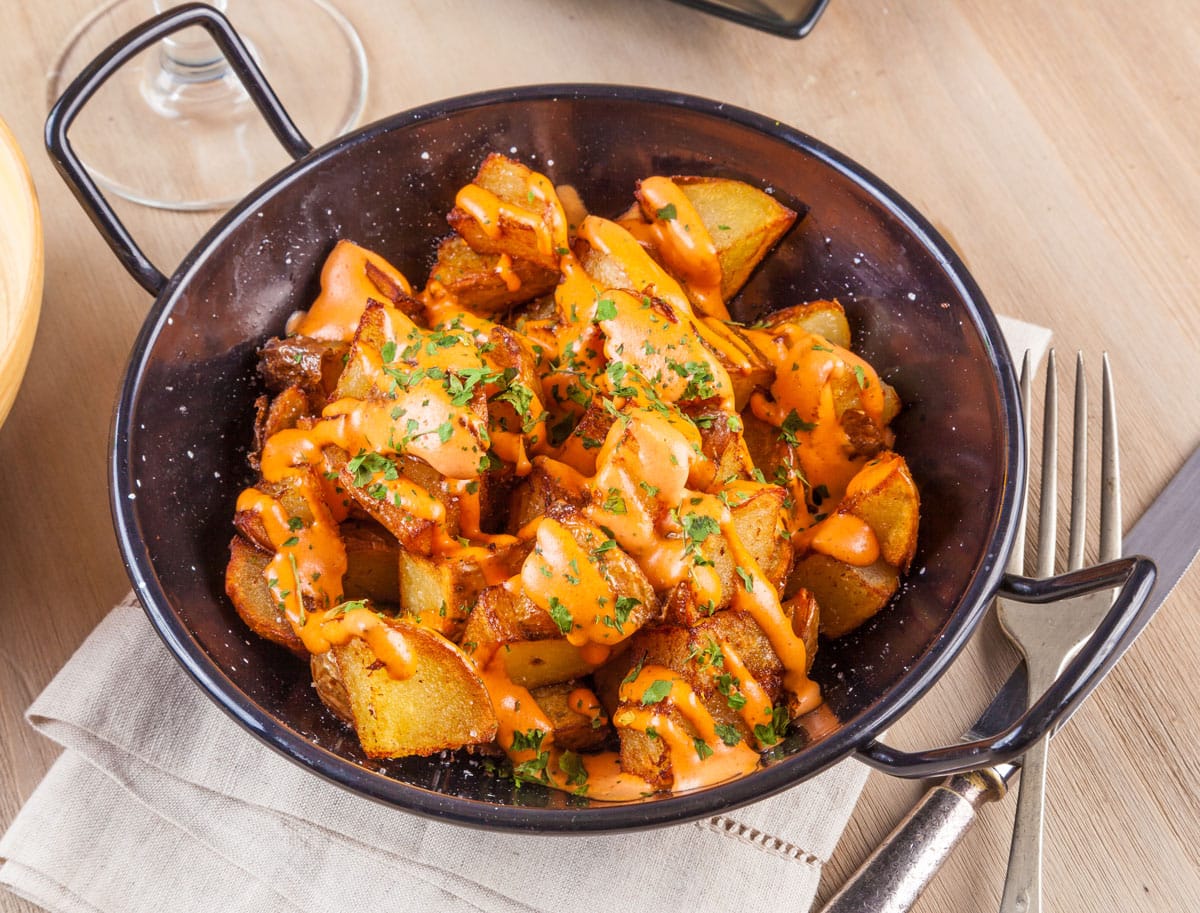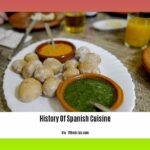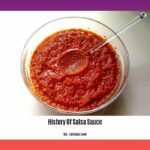Let’s grab a fork and dig into the backstory of patatas bravas, a Spanish tapa that’s been tickling taste buds for ages. We’ll uncover the roots of this beloved dish, from its humble beginnings to its starring role in culinary scenes worldwide. Get ready for a tasty adventure that’ll make you want to chow down on these crispy, saucy delights!
History of Patatas Bravas
So, you’re curious about patatas bravas, that spicy Spanish potato dish? You’re not alone! This tapa is a beloved classic with a history as rich and flavorful as its sauce. Let’s dive in!
From Humble Beginnings to Tapas Star
Imagine Madrid just after Columbus sailed the ocean blue. Tomatoes, fresh from the Americas, were causing a stir in European kitchens. This culinary shake-up in the 16th century is probably where our beloved patatas bravas first took root. Back then, it was a simple affair: potatoes, chopped roughly, fried till golden, and then doused in a spicy tomato sauce. No fancy plating, just pure, delicious flavor.
Over time, this humble dish evolved into the tapas bar icon we know and love today.
The Story Behind the “Bravas”
Ever wonder why it’s called “bravas,” which means “fierce” in Spanish? Well, one bite of that fiery sauce and you’ll understand! That kick likely comes from a traditional blend of vinegar and cayenne pepper, a combo that’ll definitely wake up your taste buds.
But here’s the fun part: just like every family has their own secret recipe, every region in Spain has its own spin on the bravas sauce. Some like it extra hot with a touch of chili, while others prefer a milder version with paprika or even a creamy garlic aioli. It’s a delicious reminder that even classic dishes have room for personal flair!
A Spanish Tradition, A Global Favorite
Patatas bravas isn’t just food in Spain, it’s practically woven into the cultural fabric. It’s the go-to snack at tapas bars, the life of the party at social gatherings, and a dish that unites people from all walks of life.
Why is it so popular? Well, it’s affordable, absolutely delicious, and offers that perfect balance of crispy potatoes and flavor-packed sauce. What’s not to love?
Patatas Bravas: The Evolution Continues
The best part about patatas bravas? It’s a dish that never stops evolving. Chefs all over the world are putting their own creative spin on this classic, experimenting with unique sauces, gourmet ingredients, and modern techniques. From Asian-inspired glazes to truffle-infused aioli, there seems to be no limit to the possibilities!
This constant reinvention is a testament to the enduring appeal of patatas bravas. It’s a dish that’s as comfortable on a tapas bar menu as it is being reimagined in a Michelin-star kitchen. So, the next time you enjoy a plate of patatas bravas, remember, you’re tasting a little piece of culinary history, one that continues to evolve even today.
What is the Culture of Patatas Bravas?
Patatas bravas are more than just some fried potatoes on a plate. They’re deeply woven into the fabric of Spanish life. Think of them as the culinary equivalent of a warm hug on a cold day – comforting, familiar, and always there for you. You’ll find them piled high in tapas bars from bustling Madrid to sunny Seville, enjoyed by everyone from seasoned locals to curious tourists.
Why are they so beloved? Well, for starters, they’re delicious! The crispy potatoes, generously slathered in spicy, tangy sauce, are simply irresistible. But it goes beyond just the taste. Patatas bravas are affordable and widely available, making them a true dish of the people. Sharing a plate of these tasty spuds creates a sense of camaraderie, breaking down social barriers and bringing people together – a key element of Spanish culture.
What’s fascinating is that while the basic concept remains the same, patatas bravas offer a glimpse into Spain’s diverse regional identities. The classic tomato-based sauce is a staple, but some regions get creative, adding their own flair with ingredients like smoky paprika, fiery chili peppers, or even a drizzle of fragrant olive oil. This regional variation is like a delicious treasure hunt for food lovers, showcasing the creativity and individuality found throughout Spain.
Let’s not forget the historical significance! Patatas bravas first appeared on the scene in the 16th century, shortly after potatoes arrived from the Americas. This simple dish reflects Spain’s history of exploration and cultural exchange, transforming a humble New World ingredient into a beloved national treasure. It’s a tangible link to the past and a testament to the enduring legacy of culinary fusion.
So, next time you find yourself digging into a plate of patatas bravas, take a moment to appreciate the rich cultural tapestry they represent. You’re not just enjoying a tasty snack, but participating in a culinary tradition that speaks volumes about Spanish history, identity, and love for good food and good company.
Where Did Patatas Originate?
We’ve already learned a bit about the potato, but let’s dig deeper into its history. Where did these beloved spuds come from?
You might be surprised to learn that potatoes are ancient! They weren’t discovered in some fancy European garden – their story starts high up in the Andes Mountains of South America, thousands of years ago. We’re talking about present-day Peru and Bolivia, where the mighty Inca civilization thrived. These folks were real pioneers when it came to farming, and potatoes quickly became a star player in their diet.
Why were potatoes such a hit back then? Well, the Andes Mountains have all sorts of climates and terrains, from sunny valleys to chilly highlands. But potatoes are tough – they could handle it all! This made them a reliable source of food for the Inca people, who depended on them to survive and thrive.
Now, fast forward a few centuries to the 1500s. Spanish explorers, always on the hunt for new treasures, stumbled upon potatoes while busy conquering the Inca Empire. They probably didn’t think these knobbly tubers were as glamorous as gold, but they were smart enough to realize how valuable potatoes could be. Imagine – a food that’s nutritious, easy to grow, and could feed a whole lot of people! So, naturally, they packed some up and brought them back to Spain.
From there, it was like a potato party across Europe! People everywhere caught on to how delicious and versatile this New World crop was. It wasn’t long before potatoes became a staple food, appearing in everything from hearty stews to simple side dishes.
Speaking of names, you might be wondering about the word “patatas.” It’s not a coincidence that it sounds a bit like “potato.” The word actually comes from “papa,” the Quechua word for, you guessed it, potato! The Inca spoke Quechua, and this linguistic link shows just how deeply rooted potatoes are in Andean culture.
While we know potatoes came from South America, researchers are still unraveling the exact details of their domestication. Some believe they were first cultivated around Lake Titicaca, the world’s highest navigable lake. Others suggest different areas of the Andes played a role. It’s like a potato puzzle, and scientists are piecing together clues from archaeology, genetics, and even linguistics!
So, the next time you enjoy a plate of fries or a loaded baked potato, take a moment to appreciate the humble potato’s long and fascinating journey. From those ancient Andean slopes to dinner plates across the globe, it’s a true testament to the power of food to connect us all.
What is the Meaning of Patatas Bravas?
So, we know these crispy fried potatoes slathered in spicy sauce are called “patatas bravas,” but did you know that “bravas” actually translates to “spicy” in Spanish? It’s like the name gives away the delicious heat you’re in for! Interestingly, they also go by another name: “patatas a lo pobre,” meaning “poor man’s potatoes.” This suggests that way back when, this dish was a budget-friendly way to fill up!
What is the History of Patatas Bravas?
Like a lot of the tasty dishes we enjoy from Spain, patatas bravas likely first popped up in Madrid sometime in the 18th century. Imagine it: simple, leftover potatoes getting a new life in a pan of hot olive oil, then generously coated in a fiery tomato sauce. That sauce, by the way, was probably a simple but flavorful concoction of – you guessed it – tomatoes, olive oil, garlic, and a sprinkle of spices. It didn’t take long for this dish to catch on, and now? Well, you can’t walk into a Spanish tapas bar without finding a plate of patatas bravas ready to be devoured!
What are the Regional Variations of Patatas Bravas?
Here’s where it gets really interesting: just like any good recipe passed down through generations, patatas bravas has seen its fair share of twists and turns depending on who’s doing the cooking. In some parts of Spain, once the potatoes are fried to that perfect golden brown, they get an extra dose of heat and texture by baking in the oven. Others might boil or steam the potatoes before they even meet the frying pan. And the sauce? Oh, the sauce is a whole other story! Some folks stick with the classic tomato-based goodness, while others switch it up with a creamy, mayonnaise-based sauce. It just goes to show that there are endless possibilities when it comes to this Spanish favorite!
What are the Ingredients in Patatas Bravas?
At its heart, patatas bravas is all about simple, delicious ingredients. You’ve got your potatoes, of course – can’t forget those! – along with good quality olive oil, pungent garlic, and a blend of spices to bring the heat. The sauce usually involves a harmonious blend of tomatoes, olive oil (again, the good stuff!), more garlic for good measure, and those all-important spices. But wait, there’s more! Depending on who’s making it, you might find onions adding a touch of sweetness, fiery peppers bringing the heat, or smoky paprika rounding out the flavor.
How are Patatas Bravas Made?
Ready for a crash course in patatas bravas making? Here’s the gist: It all starts with potatoes taking a dip in hot olive oil. The goal? Crispy, golden-brown perfection. Once they’re nice and crispy, they get drained and seasoned with a pinch of salt and pepper.
Now, let’s talk sauce. Garlic and onions sizzle in olive oil until fragrant, paving the way for a symphony of flavors. Then, in go the tomatoes, paprika, and any other spices that are calling your name. The mixture simmers patiently until it transforms into a thick, luscious sauce, just begging to be drizzled (or poured!) over those crispy potatoes. Serve it all up hot, and get ready to experience a taste of Spain!
What are the Key Takeaways?
- Patatas bravas is a Spanish tapa (small plate) that’s basically a delicious pile of fried potatoes coated in a spicy sauce.
- While its exact origins are debated, it seems to have become popular in Madrid back in the 18th century.
- Just like any good recipe, there are tons of different ways to make patatas bravas, with variations popping up all across Spain.
- No matter how you make it, the basic ingredients for patatas bravas are typically potatoes, olive oil, garlic, and a mix of spices for the sauce.
- The magic happens when crispy fried potatoes meet a flavorful, spicy tomato sauce – pure deliciousness!
What Does Bravas Mean in Spain?
So, you’re diving into the world of Spanish food, and you keep seeing “bravas” on the menu. What’s the deal with that word? Well, in the context of Spanish food, “bravas” simply means “spicy”! It’s all about that kick of heat that gets your taste buds tingling.
The word is most famously linked to a sauce – bravas sauce – that’s basically a staple in Spanish cooking, especially in Madrid where it’s thought to have originated. Think of places like Casa Pellico and La Casona – these spots are practically legendary for their bravas sauce. While you’ll mostly find it served with patatas bravas (more on that in a bit!), don’t be surprised to see it jazzing up other dishes, too! It’s surprisingly versatile.
Speaking of patatas bravas, it’s the dish most commonly associated with this fiery sauce. We’re talking crispy, golden potatoes, often cut into bite-sized chunks, generously drizzled with that smoky, spicy goodness. It’s the kind of tapa that disappears in seconds at any gathering!
What makes bravas sauce so special? It all boils down to the magic that happens when you blend sweet and hot smoked paprika. That perfect balance of sweet and spicy is what gives bravas sauce its unique and addictive flavor.
Okay, but what about those potatoes?
Now, when it comes to patatas bravas, there’s a bit of a debate. Some folks swear by a simple approach: potatoes, sauce, and maybe a sprinkle of parsley. Others like to get fancy, adding things like aioli (a garlicky mayonnaise), alioli (aioli with a touch of saffron), or even a tomato-based sauce.
The truth is, there’s no single “right” way to make patatas bravas. Each region, each bar, even each family might have their own little twist on the recipe. It’s all part of the fun!
Bravas: More Than Just a Sauce?
While patatas bravas might be the most famous dish featuring bravas sauce, it’s far from the only one. Think of bravas sauce as a flavor enhancer, ready to add a punch to all sorts of dishes. Some adventurous chefs even use it in stews and marinades for an unexpected layer of complexity.
The takeaway? When you see “bravas” in Spain, get ready for a flavor adventure! Whether it’s the classic patatas bravas or something a bit more unexpected, you’re in for a tasty experience.
Key Takeaways:
- “Bravas” means “spicy” in Spanish when talking about food.
- Bravas sauce comes from Madrid and is super popular for patatas bravas.
- The sauce gets its delicious flavor from a mix of sweet and hot smoked paprika.
- Bravas sauce isn’t just for potatoes; it can be used in lots of different dishes.
- How you pronounce it: “brah-vahs”
What is Patatas Bravas History?
We’ve already talked about how awesome patatas bravas is, but where did this spicy sensation come from? Well, imagine yourself back in 16th-century Madrid. Spain had just started bringing back treasures from the New World, including this crazy fruit called the tomato. Now, potatoes were already a thing in Spain, but someone, somewhere had the bright idea of mixing these two together. And bam! Patatas bravas was probably born!
Of course, like any good recipe, it didn’t stay the same forever. As patatas bravas spread across Spain, each region added its own little twist. Those creative chefs in Catalonia and Valencia? They decided to spice things up (literally!) by adding things like olive oil, chili peppers, paprika, and even a splash of vinegar to the sauce.
So, the next time you’re digging into a plate of patatas bravas, remember, you’re not just eating delicious fried potatoes. You’re experiencing a tasty piece of history!
Where are Patatas Bravas Most Popular?
You know how some dishes just capture the heart of a place? That’s patatas bravas in Spain. While you can find these crispy, sauce-covered potato bites practically everywhere in the country – seriously, what tapas bar doesn’t have them? – their story starts in Madrid.
Think of Madrid as the OG patatas bravas hotspot. They’re the real deal there, often served with a fiery red sauce that’s big on flavor but skips the garlic aioli you might find elsewhere. It’s a classic for a reason!
But hey, good food travels fast, and patatas bravas are no exception. From local tapas bars to restaurants around the world, these tasty potato treats have become a global favorite.
And while the heart of patatas bravas will always be in Spain, chefs around the world have been putting their own spin on the dish. New sauces, different spices, creative twists – it’s pretty cool to see how this Spanish classic has inspired so many tasty variations.
So, whether you’re digging into a plate of patatas bravas on the bustling streets of Madrid or enjoying a unique take on them at your favorite local spot, one thing’s for sure: this dish has definitely earned its place as a culinary star.
What Countries Eat Patatas Bravas?
You know how some dishes just seem to capture the spirit of a whole country? Well, patatas bravas is like that for Spain. It’s not just about the food, though those crispy potatoes and that spicy, tangy sauce are amazing. It’s about the whole experience—sharing small plates with friends, enjoying a drink or two, and soaking up the lively atmosphere of a Spanish tapas bar.
While Madrid proudly claims the title of patatas bravas birthplace, its popularity has spread like wildfire. Imagine yourself wandering through the sun-drenched streets of Barcelona, or perhaps finding a cozy tapas bar tucked away in a bustling London neighborhood—chances are, patatas bravas will be there waiting for you.
Think of it as a culinary ambassador, introducing the world to the joys of Spanish cuisine one delicious bite at a time. While no official list dictates every single country where you can find this beloved tapa, it’s safe to say patatas bravas has likely found its way onto menus wherever Spanish culinary influence has taken root. From the Americas to Asia and many places in between, the love for patatas bravas continues to grow, proving that some flavors are simply irresistible, no matter where you go.
What Spanish Country is Known for Potatoes?
Okay, so we’ve been talking about Spain and its food, which is amazing, by the way! But when it comes to potatoes, there’s one dish that just screams “Spain,” and that’s patatas bravas. You know, those crispy, golden potatoes covered in a delicious, spicy sauce? Yeah, those! They’re not just tasty; they actually have a pretty cool history, too.
Think back to the 1500s when Spanish explorers first brought potatoes back from South America. It didn’t take long for potatoes to become a big deal in Spain. People were like, “Hey, we can do a lot with this!” And boom! Patatas bravas were born.
Now, the early versions of this dish started in Madrid. Imagine this: crispy potato chunks drenched in a tangy, slightly spicy tomato sauce. They called it “bravas,” which means “fiery” in Spanish, and trust me, the name fits!
But here’s the thing about Spain – every region likes to add its own spin to classic dishes. So, you’ll find different versions of patatas bravas depending on where you go. Head over to Catalonia, and they might spice things up with olive oil, chili, and paprika in their sauce. In Valencia? Get ready for a creamy surprise because they often add aioli, which is a garlicky mayonnaise, to their patatas bravas.
But no matter how you make them, patatas bravas are a must-have when you’re in Spain. Seriously, you’ll find them in pretty much every tapas bar across the country! They’re cheap, super tasty, and let’s be real, who can resist a plate of crispy potatoes with that incredible sauce?
And guess what? Patatas bravas aren’t just famous in Spain anymore; they’ve gone global! People all over the world have fallen in love with this dish. Chefs everywhere are even coming up with their own unique versions, experimenting with different sauces and ingredients.
So, there you have it! Patatas bravas are like the potato ambassador of Spain, and once you try them, you’ll understand why they’re so incredibly popular!
What Country Calls Potatoes Patatas?
So, we’ve been talking about potatoes and all the different names they have around the world. Well, if you find yourself in a Spanish market or restaurant, you’ll probably hear potatoes called “patatas.” That’s right, Spain is the main place where potatoes are commonly referred to as “patatas.”
Now, you might be wondering where this word “patata” came from. It’s actually pretty interesting. It all started with the sweet potato, believe it or not. The indigenous people of Haiti had a word for sweet potato, and that word eventually evolved into “patata.” From there, it seems the word traveled to Spain, where it became associated with the potato we know and love today.
But hold on a minute, it’s not quite as simple as that! Even within Spain, you’ll find some regional differences. For example, if you’re hanging out in the Canary Islands or parts of Andalusia, you might hear people using the word “papa” for potatoes instead.
So, what’s the deal with “papa”? Well, that’s a whole other story! “Papa” is another word for potato that’s popular in many parts of Latin America and other Spanish-speaking regions. It’s like a linguistic family tree, with “patata” and “papa” branching out from the same root.
What’s fascinating is how language can change and adapt over time and across different places. While “patata” has become the most common word for potato in Spain, “papa” remains a popular choice in other parts of the Spanish-speaking world. It just goes to show that even something as ordinary as a potato can have a rich and complex linguistic history!
What Food is Spain Most Famous For?
Picking just one food to represent all of Spain is like trying to pick a favorite star in the sky! From juicy olives and tangy cheeses to plates piled high with colorful tapas, Spanish cuisine is a delicious journey. But if there’s one dish that constantly pops up in conversations about Spanish food, it’s got to be patatas bravas. You could say it’s the reigning king (or queen) of Spanish tapas!
Now, you might be thinking, “Potatoes? Really? That’s it?” And it’s true, the idea sounds pretty simple. But trust me, these aren’t your average spuds. We’re talking about perfectly fried potatoes, crispy on the outside and fluffy on the inside, all coated in a gloriously spicy sauce that’ll have you craving just one more bite (and then maybe just one more after that).
The beauty of patatas bravas is that every region, and maybe even every bar, has its own special twist on the recipe. Some folks like their potatoes cubed, others prefer wedges, and the sauces can range from fiery hot to smooth and smoky. But no matter how they’re made, patatas bravas always hit the spot. It’s a dish that perfectly embodies the spirit of Spanish cuisine: simple, flavorful, and meant to be shared with good company.
So, where did these spicy little wonders come from? Well, that’s a bit of a mystery. Some say they were dreamed up in Madrid sometime in the 1800s, and that fiery name “bravas” (meaning “fierce” or “brave”) is a nod to the Spanish soldiers of the time. It’s a fun story, right? And while we might never know exactly how patatas bravas came to be, one thing’s for sure: they’ve definitely earned their place as a true icon of Spanish food.
Discover the rich history and artistry behind one of Mexico’s most iconic traditions in our extensive guide to the history of Papel Picado. Immerse yourself in the captivating tale of the history of Paynes Prairie, a place where nature and history intertwine, offering a unique glimpse into Florida’s past.
- Georgia Platform: A Southern Strategy, 1850s - March 31, 2025
- How many weeks is 40 days: Quick Conversion Guide for Accurate Results - March 31, 2025
- How many feet is 300 meters? 984 Feet: Understand Length Conversions Easily - March 31, 2025
















